KIA Optima 2006 2.G Workshop Manual
Manufacturer: KIA, Model Year: 2006, Model line: Optima, Model: KIA Optima 2006 2.GPages: 225, PDF Size: 3.77 MB
Page 51 of 225
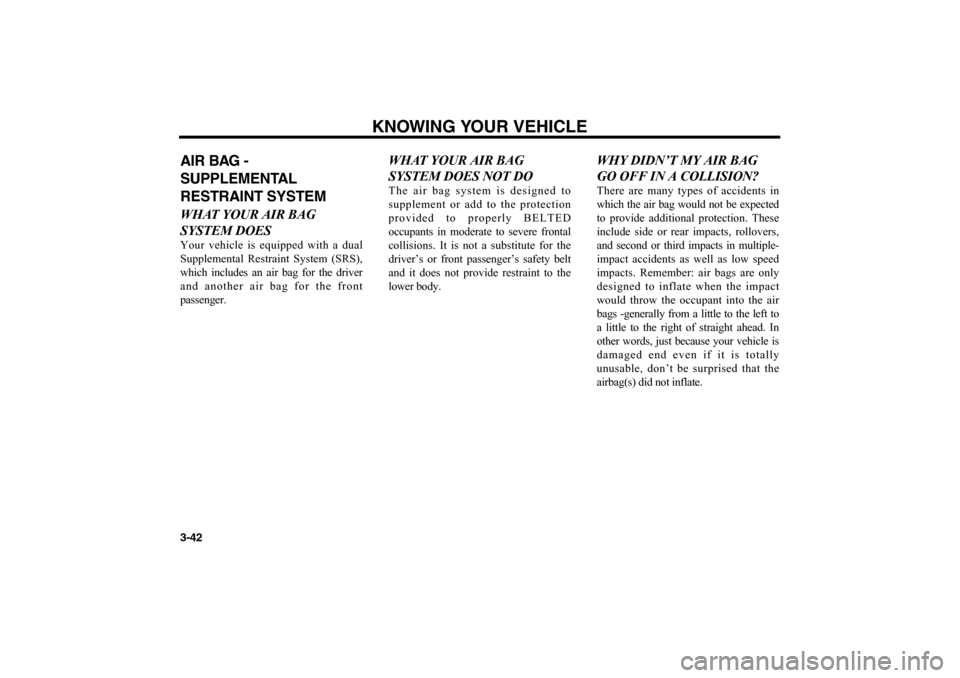
KNOWING YOUR VEHICLE
3-42AIR BAG -
SUPPLEMENTAL
RESTRAINT SYSTEM WHAT YOUR AIR BAG
SYSTEM DOESYour vehicle is equipped with a dual
Supplemental Restraint System (SRS),
which includes an air bag for the driver
and another air bag for the front
passenger.
WHAT YOUR AIR BAG
SYSTEM DOES NOT DOThe air bag system is designed to
supplement or add to the protection
provided to properly BELTED
occupants in moderate to severe frontal
collisions. It is not a substitute for the
driver’s or front passenger’s safety belt
and it does not provide restraint to the
lower body.
WHY DIDN’T MY AIR BAG
GO OFF IN A COLLISION?There are many types of accidents in
which the air bag would not be expected
to provide additional protection. These
include side or rear impacts, rollovers,
and second or third impacts in multiple-
impact accidents as well as low speed
impacts. Remember: air bags are only
designed to inflate when the impact
would throw the occupant into the air
bags -generally from a little to the left to
a little to the right of straight ahead. In
other words, just because your vehicle is
damaged end even if it is totally
unusable, don’t be surprised that the
airbag(s) did not inflate.
MS-CNA-Eng 3.QXD 7/25/2005 5:17 PM Page 42
Page 52 of 225
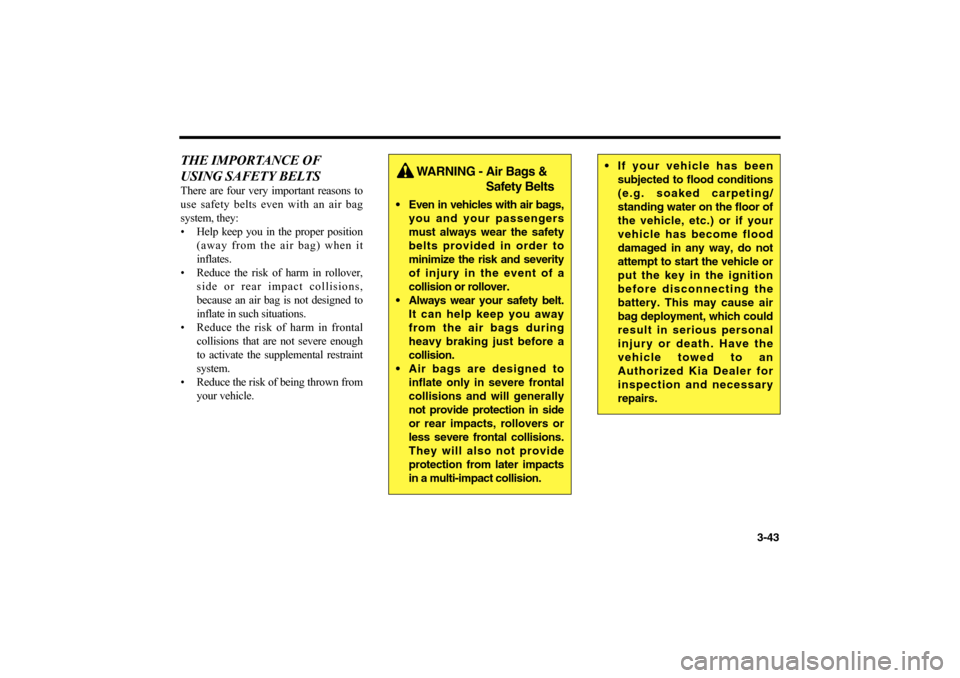
3-43
THE IMPORTANCE OF
USING SAFETY BELTSThere are four very important reasons to
use safety belts even with an air bag
system, they:
• Help keep you in the proper position
(away from the air bag) when it
inflates.
• Reduce the risk of harm in rollover,
side or rear impact collisions,
because an air bag is not designed to
inflate in such situations.
• Reduce the risk of harm in frontal
collisions that are not severe enough
to activate the supplemental restraint
system.
• Reduce the risk of being thrown from
your vehicle.
WARNING - Air Bags &
Safety Belts
Even in vehicles with air bags,
you and your passengers
must always wear the safety
belts provided in order to
minimize the risk and severity
of injury in the event of a
collision or rollover.
Always wear your safety belt.
It can help keep you away
from the air bags during
heavy braking just before a
collision.
Air bags are designed to
inflate only in severe frontal
collisions and will generally
not provide protection in side
or rear impacts, rollovers or
less severe frontal collisions.
They will also not provide
protection from later impacts
in a multi-impact collision.
If your vehicle has been
subjected to flood conditions
(e.g. soaked carpeting/
standing water on the floor of
the vehicle, etc.) or if your
vehicle has become flood
damaged in any way, do not
attempt to start the vehicle or
put the key in the ignition
before disconnecting the
battery. This may cause air
bag deployment, which could
result in serious personal
injury or death. Have the
vehicle towed to an
Authorized Kia Dealer for
inspection and necessary
repairs.
MS-CNA-Eng 3.QXD 7/25/2005 5:17 PM Page 43
Page 53 of 225

KNOWING YOUR VEHICLE
3-44AIR BAG SYSTEM
COMPONENTSThe main components of your vehicle’s
SRS are:
• One air bag in the steering wheel for
the driver, and another in the
dashboard for the front passenger.
• A diagnostic system that continually
monitors system operation.
• An indicator light to warn you of a
possible problem with the system.
• Emergency power backup in case
your car’s electrical system is
disconnected in a crash.To indicate that your vehicle is equipped
with air bags, the air bag covers on the
steering wheel and on the dashboard are
marked with “SRS AIR BAG.”
HOW THE AIR BAG SYSTEM
WORKSThe driver’s air bag is stored in the
center of the steering wheel. The
passenger side air bag is stored in the
front instrument panel above the glove
box.
If you ever have a severe frontal
collision, your air bags will instantly
inflate to help protect you from serious
physical injury.
There is no single vehicle speed at which
the air bags will inflate. Generally, air
bags are designed to inflate in severe
frontal collisions. The air bag
Supplemental Restraint System (SRS)
reacts to the severity of a collision and its
direction. These two factors determine
whether the sensors send out an
electronic deployment or inflation signal.
Whether the air bags will inflate depends
on a number of factors including vehicle
speed, angle of impact and the density
and stiffness of the vehicles or objects
that your vehicle hits in the collision.
R
E
S
A
C
C
E
L
C
A
N
C
E
L
C
O
A
S
T
S
E
T
MMSA3037A
MS-CNA-Eng 3.QXD 7/25/2005 5:17 PM Page 44
Page 54 of 225
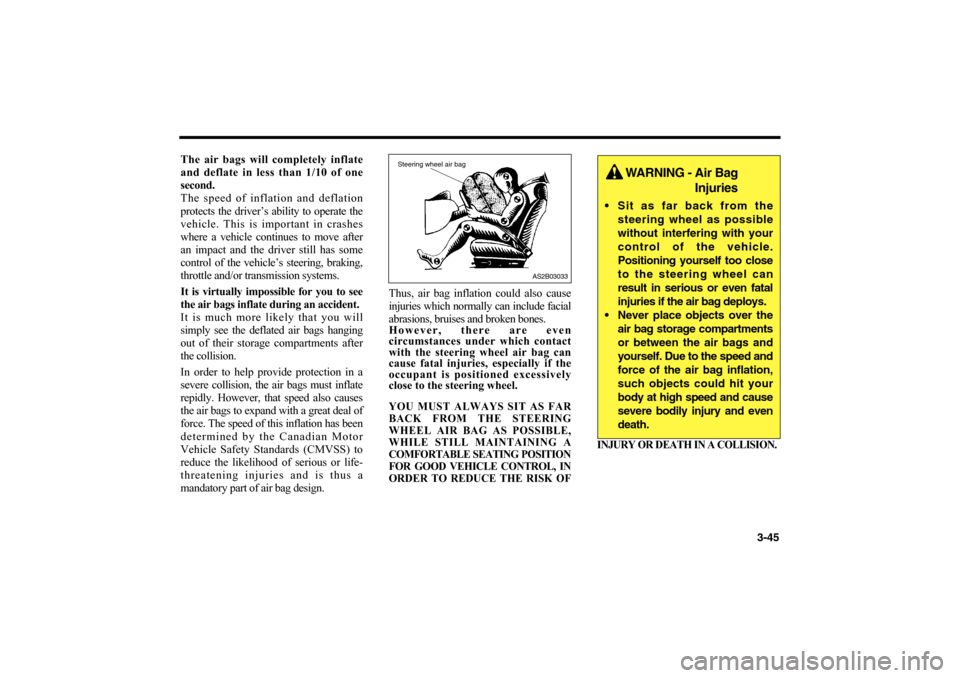
3-45 The air bags will completely inflate
and deflate in less than 1/10 of one
second.
The speed of inflation and deflation
protects the driver’s ability to operate the
vehicle. This is important in crashes
where a vehicle continues to move after
an impact and the driver still has some
control of the vehicle’s steering, braking,
throttle and/or transmission systems.
It is virtually impossible for you to see
the air bags inflate during an accident.
It is much more likely that you will
simply see the deflated air bags hanging
out of their storage compartments after
the collision.
In order to help provide protection in a
severe collision, the air bags must inflate
repidly. However, that speed also causes
the air bags to expand with a great deal of
force. The speed of this inflation has been
determined by the Canadian Motor
Vehicle Safety Standards (CMVSS) to
reduce the likelihood of serious or life-
threatening injuries and is thus a
mandatory part of air bag design.Thus, air bag inflation could also cause
injuries which normally can include facial
abrasions, bruises and broken bones.
However, there are even
circumstances under which contact
with the steering wheel air bag can
cause fatal injuries, especially if the
occupant is positioned excessively
close to the steering wheel.
YOU MUST ALWAYS SIT AS FAR
BACK FROM THE STEERING
WHEEL AIR BAG AS POSSIBLE,
WHILE STILL MAINTAINING A
COMFORTABLE SEATING POSITION
FOR GOOD VEHICLE CONTROL, IN
ORDER TO REDUCE THE RISK OFINJURY OR DEATH IN A COLLISION.
AS2B03033 Steering wheel air bag
WARNING - Air Bag
Injuries
Sit as far back from the
steering wheel as possible
without interfering with your
control of the vehicle.
Positioning yourself too close
to the steering wheel can
result in serious or even fatal
injuries if the air bag deploys.
Never place objects over the
air bag storage compartments
or between the air bags and
yourself. Due to the speed and
force of the air bag inflation,
such objects could hit your
body at high speed and cause
severe bodily injury and even
death.
MS-CNA-Eng 3.QXD 7/25/2005 5:17 PM Page 45
Page 55 of 225
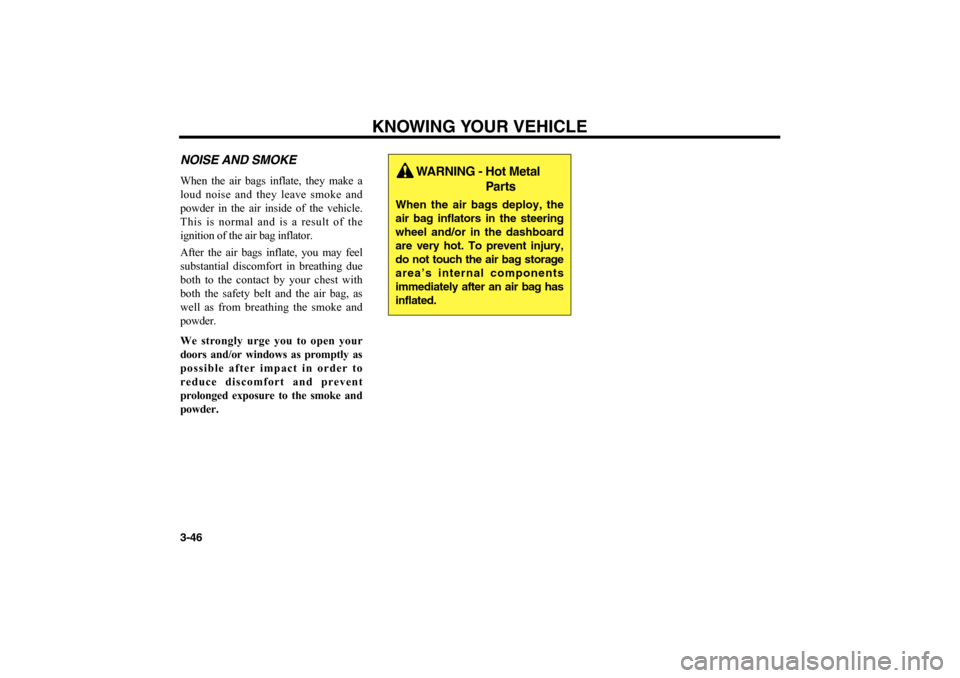
KNOWING YOUR VEHICLE
3-46NOISE AND SMOKEWhen the air bags inflate, they make a
loud noise and they leave smoke and
powder in the air inside of the vehicle.
This is normal and is a result of the
ignition of the air bag inflator.
After the air bags inflate, you may feel
substantial discomfort in breathing due
both to the contact by your chest with
both the safety belt and the air bag, as
well as from breathing the smoke and
powder.
We strongly urge you to open your
doors and/or windows as promptly as
possible after impact in order to
reduce discomfort and prevent
prolonged exposure to the smoke and
powder.
WARNING - Hot Metal
Parts
When the air bags deploy, the
air bag inflators in the steering
wheel and/or in the dashboard
are very hot. To prevent injury,
do not touch the air bag storage
area’s internal components
immediately after an air bag has
inflated.
MS-CNA-Eng 3.QXD 7/25/2005 5:17 PM Page 46
Page 56 of 225
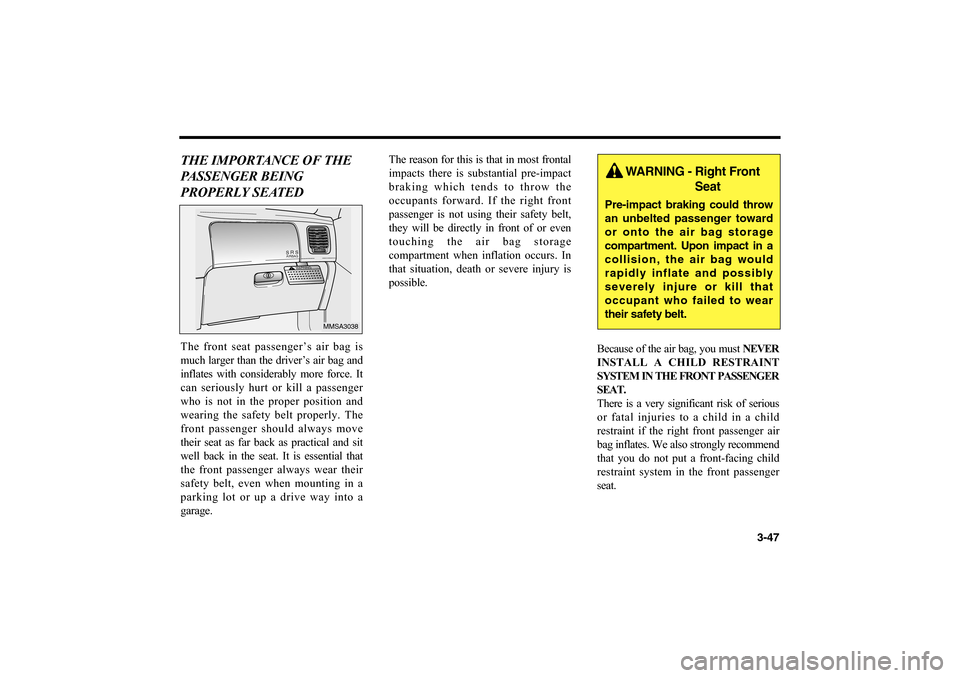
3-47
THE IMPORTANCE OF THE
PASSENGER BEING
PROPERLY SEATEDThe front seat passenger’s air bag is
much larger than the driver’s air bag and
inflates with considerably more force. It
can seriously hurt or kill a passenger
who is not in the proper position and
wearing the safety belt properly. The
front passenger should always move
their seat as far back as practical and sit
well back in the seat. It is essential that
the front passenger always wear their
safety belt, even when mounting in a
parking lot or up a drive way into a
garage.The reason for this is that in most frontal
impacts there is substantial pre-impact
braking which tends to throw the
occupants forward. If the right front
passenger is not using their safety belt,
they will be directly in front of or even
touching the air bag storage
compartment when inflation occurs. In
that situation, death or severe injury is
possible.
Because of the air bag, you must NEVER
INSTALL A CHILD RESTRAINT
SYSTEM IN THE FRONT PASSENGER
SEAT.
There is a very significant risk of serious
or fatal injuries to a child in a child
restraint if the right front passenger air
bag inflates. We also strongly recommend
that you do not put a front-facing child
restraint system in the front passenger
seat.
S R SAIRBAGWARNING
MMSA3038
WARNING - Right Front
Seat
Pre-impact braking could throw
an unbelted passenger toward
or onto the air bag storage
compartment. Upon impact in a
collision, the air bag would
rapidly inflate and possibly
severely injure or kill that
occupant who failed to wear
their safety belt.
MS-CNA-Eng 3.QXD 7/25/2005 5:17 PM Page 47
Page 57 of 225
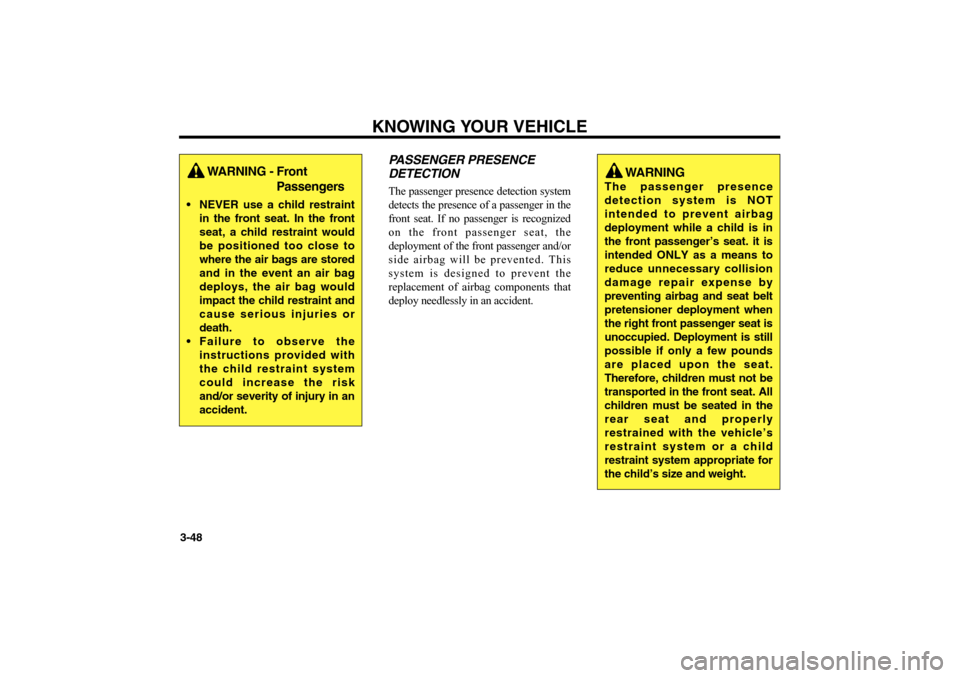
KNOWING YOUR VEHICLE
3-48
PASSENGER PRESENCE
DETECTIONThe passenger presence detection system
detects the presence of a passenger in the
front seat. If no passenger is recognized
on the front passenger seat, the
deployment of the front passenger and/or
side airbag will be prevented. This
system is designed to prevent the
replacement of airbag components that
deploy needlessly in an accident.
WARNING - Front
Passengers
NEVER use a child restraint
in the front seat. In the front
seat, a child restraint would
be positioned too close to
where the air bags are stored
and in the event an air bag
deploys, the air bag would
impact the child restraint and
cause serious injuries or
death.
Failure to observe the
instructions provided with
the child restraint system
could increase the risk
and/or severity of injury in an
accident.
WARNING
The passenger presence
detection system is NOT
intended to prevent airbag
deployment while a child is in
the front passenger’s seat. it is
intended ONLY as a means to
reduce unnecessary collision
damage repair expense by
preventing airbag and seat belt
pretensioner deployment when
the right front passenger seat is
unoccupied. Deployment is still
possible if only a few pounds
are placed upon the seat.
Therefore, children must not be
transported in the front seat. All
children must be seated in the
rear seat and properly
restrained with the vehicle’s
restraint system or a child
restraint system appropriate for
the child’s size and weight.
MS-CNA-Eng 3.QXD 7/25/2005 5:17 PM Page 48
Page 58 of 225
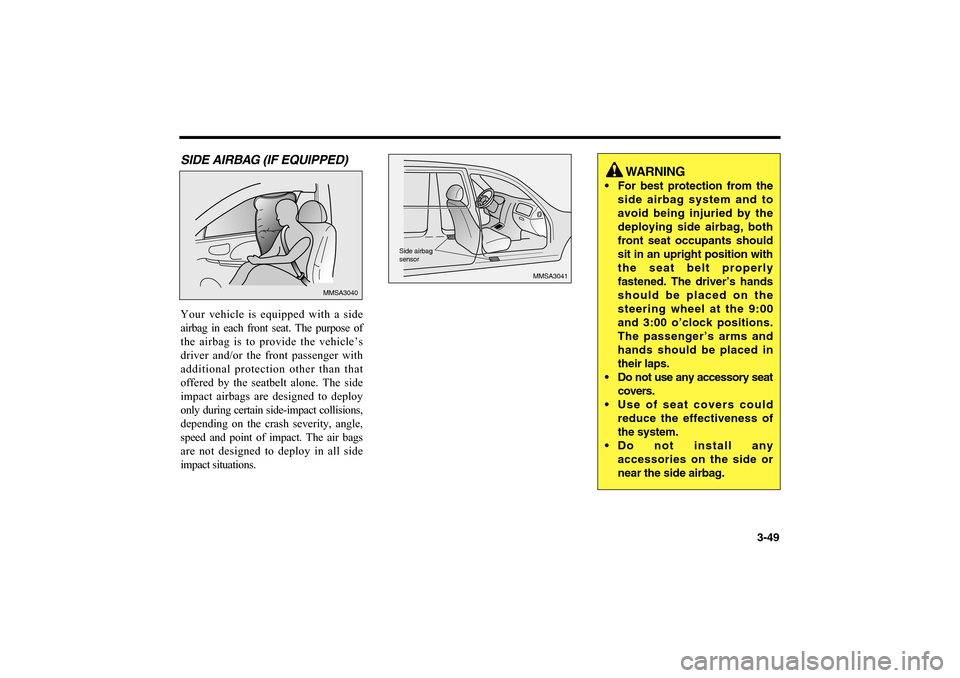
3-49
SIDE AIRBAG (IF EQUIPPED)Your vehicle is equipped with a side
airbag in each front seat. The purpose of
the airbag is to provide the vehicle’s
driver and/or the front passenger with
additional protection other than that
offered by the seatbelt alone. The side
impact airbags are designed to deploy
only during certain side-impact collisions,
depending on the crash severity, angle,
speed and point of impact. The air bags
are not designed to deploy in all side
impact situations.
MMSA3041 Side airbag
sensor
MMSA3040
WARNING
For best protection from the
side airbag system and to
avoid being injuried by the
deploying side airbag, both
front seat occupants should
sit in an upright position with
the seat belt properly
fastened. The driver’s hands
should be placed on the
steering wheel at the 9:00
and 3:00 o’clock positions.
The passenger’s arms and
hands should be placed in
their laps.
Do not use any accessory seat
covers.
Use of seat covers could
reduce the effectiveness of
the system.
Do not install any
accessories on the side or
near the side airbag.
MS-CNA-Eng 3.QXD 7/25/2005 5:17 PM Page 49
Page 59 of 225
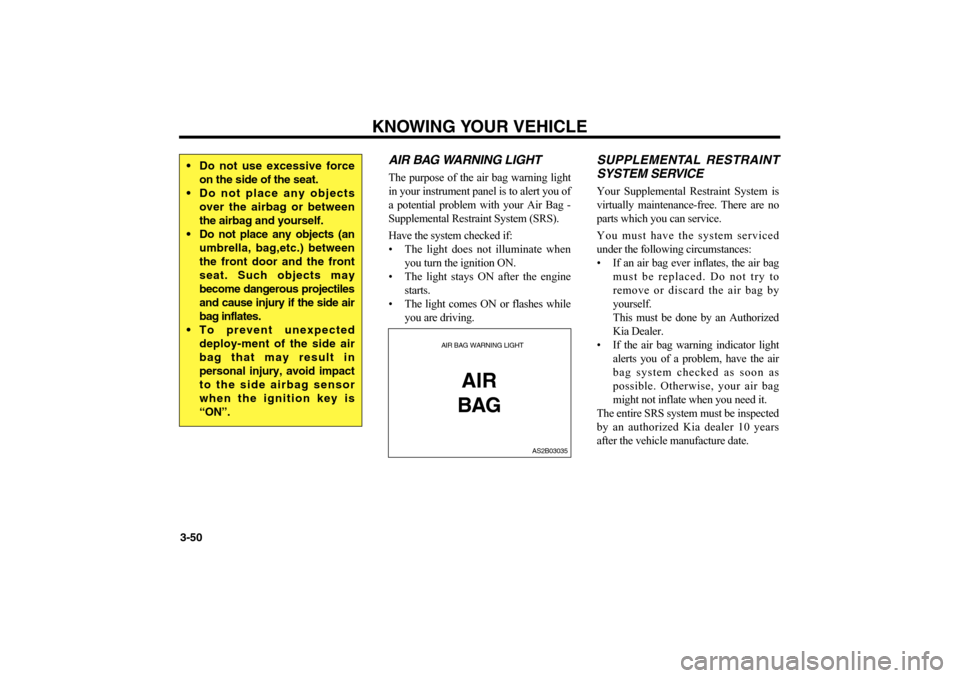
KNOWING YOUR VEHICLE
3-50
AIR BAG WARNING LIGHTThe purpose of the air bag warning light
in your instrument panel is to alert you of
a potential problem with your Air Bag -
Supplemental Restraint System (SRS).
Have the system checked if:
• The light does not illuminate when
you turn the ignition ON.
• The light stays ON after the engine
starts.
• The light comes ON or flashes while
you are driving.
SUPPLEMENTAL RESTRAINT
SYSTEM SERVICEYour Supplemental Restraint System is
virtually maintenance-free. There are no
parts which you can service.
You must have the system serviced
under the following circumstances:
• If an air bag ever inflates, the air bag
must be replaced. Do not try to
remove or discard the air bag by
yourself.
This must be done by an Authorized
Kia Dealer.
• If the air bag warning indicator light
alerts you of a problem, have the air
bag system checked as soon as
possible. Otherwise, your air bag
might not inflate when you need it.
The entire SRS system must be inspected
by an authorized Kia dealer 10 years
after the vehicle manufacture date.
AIR BAG WARNING LIGHT
AIR
BAG
AS2B03035
Do not use excessive force
on the side of the seat.
Do not place any objects
over the airbag or between
the airbag and yourself.
Do not place any objects (an
umbrella, bag,etc.) between
the front door and the front
seat. Such objects may
become dangerous projectiles
and cause injury if the side air
bag inflates.
To prevent unexpected
deploy-ment of the side air
bag that may result in
personal injury, avoid impact
to the side airbag sensor
when the ignition key is
“ON”.
MS-CNA-Eng 3.QXD 7/25/2005 5:17 PM Page 50
Page 60 of 225
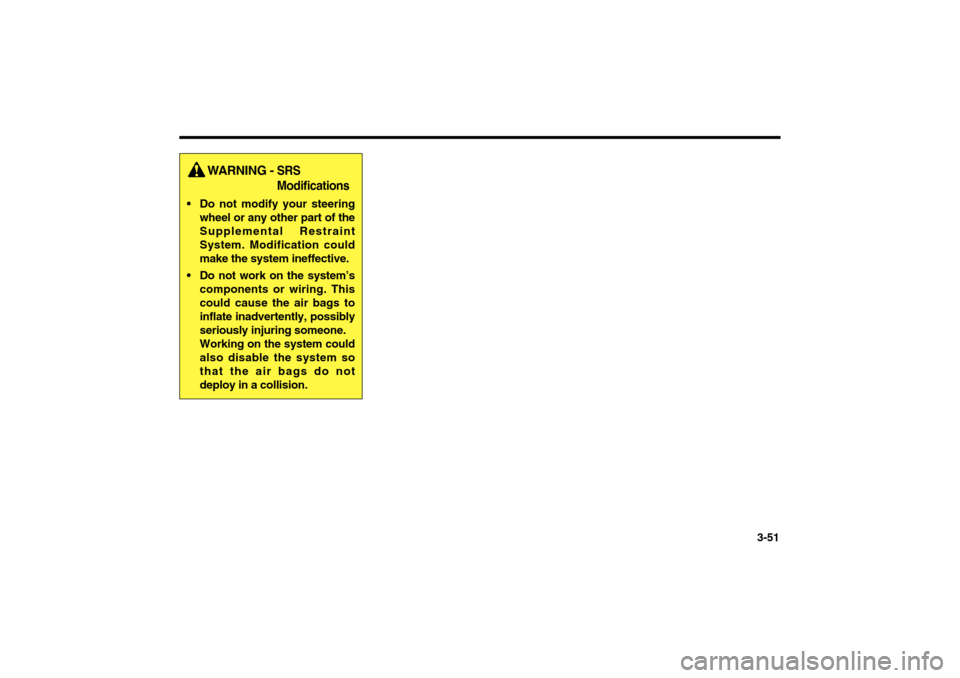
3-51
WARNING -
SRS
Modifications
Do not modify your steering
wheel or any other part of the
Supplemental Restraint
System. Modification could
make the system ineffective.
Do not work on the system’s
components or wiring. This
could cause the air bags to
inflate inadvertently, possibly
seriously injuring someone.
Working on the system could
also disable the system so
that the air bags do not
deploy in a collision.
MS-CNA-Eng 3.QXD 7/25/2005 5:17 PM Page 51